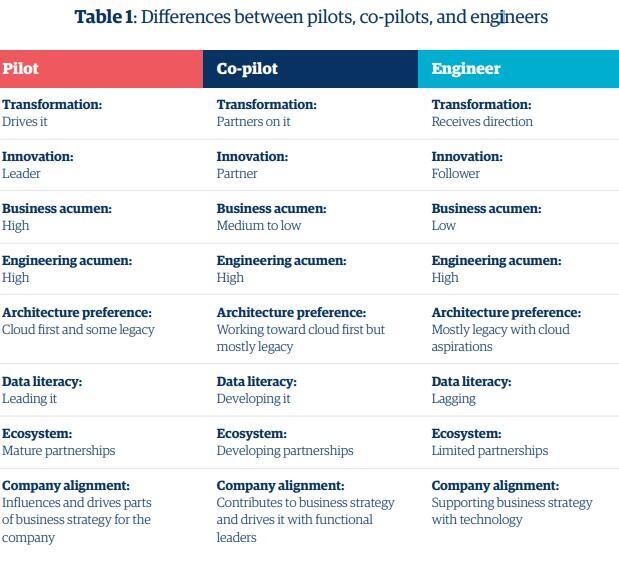
CIOs: Are you a pilot, co-pilot or engineer?
A study by global professional services firm Genpact finds most CIO organizations are not fully prepared for the next major business disruption.

Image: iStockphoto/milindri
CIOs are increasingly being asked to advise the board, lead change and drive growth. A new study looked at how CIOs are preparing and prioritizing for the future and discovered three distinct roles: Pilots, co-pilots and engineers, with varying levels of influence over guiding change in their companies.
Pilots are innovating, co-pilots are modernizing and engineers are playing catch up, according to the study of 500 CIOs and technology leaders, by Genpact, a global professional services firm. Only 22% are pilots, who are leading the way and driving the transformation journey strategically across core business functions. The largest cohort, 61%, are co-pilots partnering with business leaders to shape and deliver transformation. Seventeen percent are the engineers, simply executing, the Genpact study said.
SEE: CIOs and CTOs say they adapted well to disruptions caused by COVID-19 (TechRepublic)
“Transformation pilot CIOs that drive alignment across the C-suite and put the organizational focus on building resilience and innovation will be the co-creators of new business models and future-ready companies,” said Sanjay Srivastava, Genpact’s chief digital officer, who presented the findings during a session at the MIT Sloan CIO Symposium. “CIOs who do not will see their organizations struggle.”
Organizations remain unprepared for major business disruption
The study indicates that despite a time of unprecedented investment in digital infrastructure and transformation, more than two-thirds (68%) of CIO respondents worldwide believe their IT organization is not completely prepared to help their companies withstand another major business disruption. Further, less than half (44%) agree strongly that they are well-positioned to support company growth after the pandemic, the Genpact report said.
“We mostly serve Fortune 500 companies, and we see very clearly that enterprise architecture is evolving and there’s a lot of focus on slimmer core IT systems,” Srivastava said, meaning that organizations are investing much less in legacy systems. “More is going into data layers, systems of engagement and into microservices,” he said.
The IT investment paradigm is changing to the modernization of apps, simplifying the app stack and making the customer and employee experience the metric and not just the cost of operations, Srivastava said.
An important scorecard metric for CIOs is whether they delivered what they were expected to and within their budget, he said. This is a big change from previous years and much has been driven by the pandemic.
“Every aspect of life and many things around the work we do has changed,” Srivastava said. “One change is customer loyalty, stickiness and revenue growth are more closely tied to the experience delivered. That’s brought a lot of focus to organizations to drive the right experience.”
No longer can organizations operate in silos, he said. This requires that leaders invert their thinking and approach customer experiences as an “end-to-end lifecycle journey … that’s actually the biggest unlock happening now.”
These learnings have come from watching how the startups operate, Srivastava said. They don’t have to worry about the legacy IT systems that most large companies have. “The job of large companies is transforming all that legacy debt to a modern IT stack that can deliver true end-to-end customer … experiences.”

Image: Genpact and Forrester
The evolving CIO and their ability to influence the CEO
The industries transforming the most, such as financial services, media and consumer goods tend to have more pilots and co-pilots and fewer engineers, he said. In general, the utilities sector and broad-based manufacturing tend to be lagging.
“The right way to think about this is the role of the CIO is changing and second, the tools of the trade they bring to the job are completely evolving” into the cloud, composable services, data analytics and AI, Srivastava said.
“Those are tools these CIOs are now bringing to the table and the survey reflects that’s where they want to invest and have seen successes,” he said.
The CIO must also be able to influence the CEO’s agenda and make sure they will get behind the transformation, Srivastava said. “Digital is easy, transformation is harder. That’s where the real work is and to do that you need the CEO 200% in the game. If you don’t have support, you’re wasting your time.
However, Srivastava said more CEOs are backing transformation initiatives. “We’re finding more and more CEOs are directly getting engaged and as result, CIOs are increasingly reporting to [them] and even if not, they’re spending a lot of their time influencing CEOs.”
Other findings from Genpact’s CIO study include:
CIOs are aligned on the need to be data-driven. Almost all (98%) agree that their companies make data-driven decisions to realize business value. Respondents cite AI and ML as the top technologies that will help CIOs achieve their goals, and the top choice for investment if they had additional financial resources. These technologies allow CIOs to make the most of the data at their disposal, generating predictive insights for more informed decision-making.
As the pandemic forced more focus on employee safety, with 41% of respondents saying that their CIO organization helps track employee wellbeing, human resources still ranked last among the functional areas prioritized for full-stack technology investment over the next two years. This warns of a potential disconnect in meeting employee needs with new remote and hybrid office models emerging.
Accountability for the customer experience is something 40% of transformation pilots believe their CIO organization is responsible for, compared to just 22% of engineers. In fact, CIOs are uniquely positioned to connect CX and employee experience technologies. Only when employees are digitally enabled can they deliver the experiences customers expect.
“CIOs who are not prepared from business disruption and post-pandemic growth risk becoming obsolete,” said Tom Davenport, distinguished professor at Babson College, visiting professor at Oxford, and research fellow at the MIT Initiative on the Digital Economy, who is a co-author of the Genpact study, in a statement. “Genpact’s research provides insights on how all three types of CIOs can take the pilot’s seat to accelerate digital business transformation and business growth.”
Genpact worked with the MIT Sloan CIO Symposium and Wakefield Research to survey CIOs and other IT leaders in March. Respondents are from banking and financial services, insurance, healthcare and life sciences, high tech, consumer goods and retail, media and entertainment and industrial manufacturing. Respondents live in the US, Canada, UK, Germany, Singapore, Japan, or Australia.
Also see
Stay connected with us on social media platform for instant update click here to join our Twitter, & Facebook
We are now on Telegram. Click here to join our channel (@TechiUpdate) and stay updated with the latest Technology headlines.
For all the latest Technology News Click Here
For the latest news and updates, follow us on Google News.


